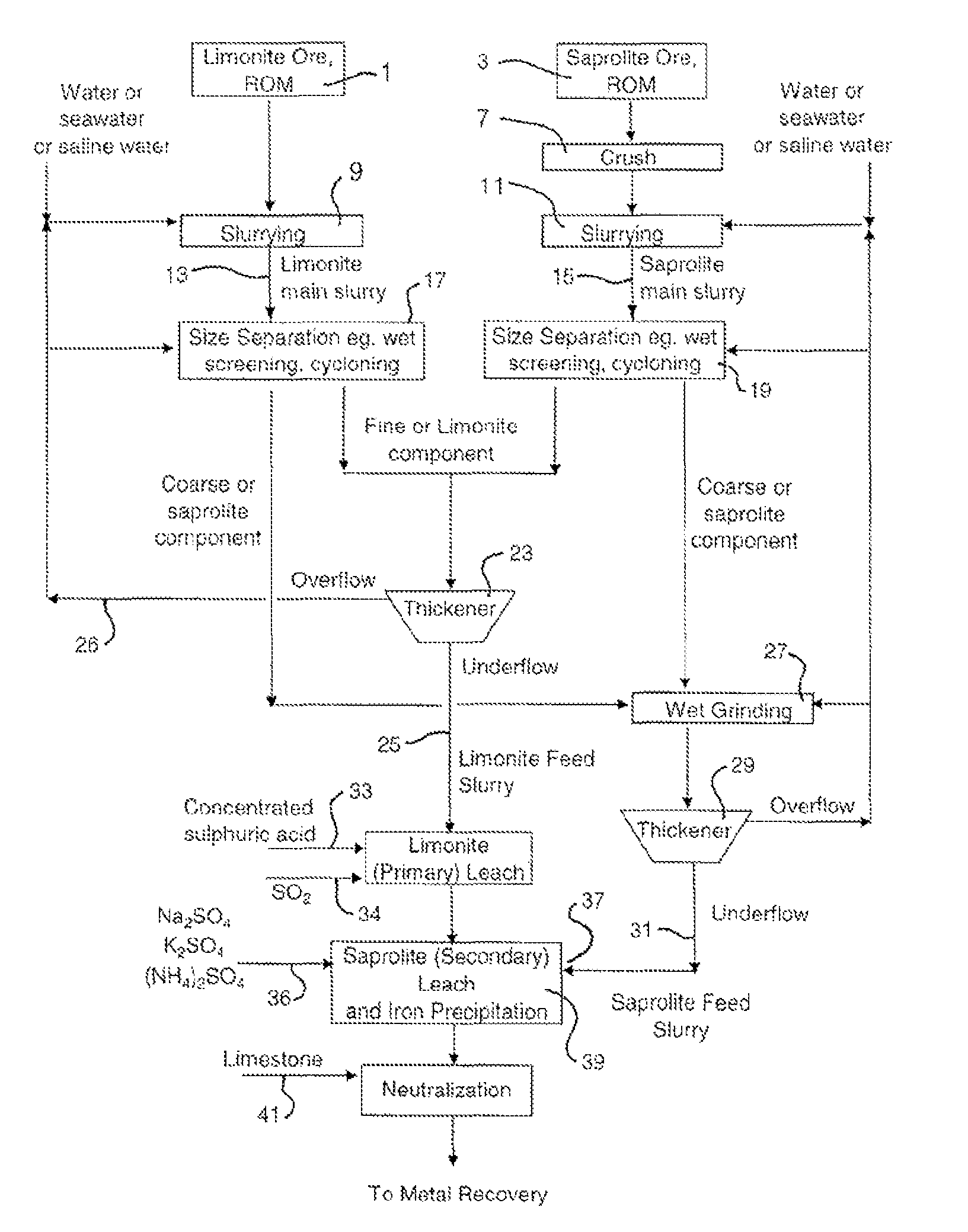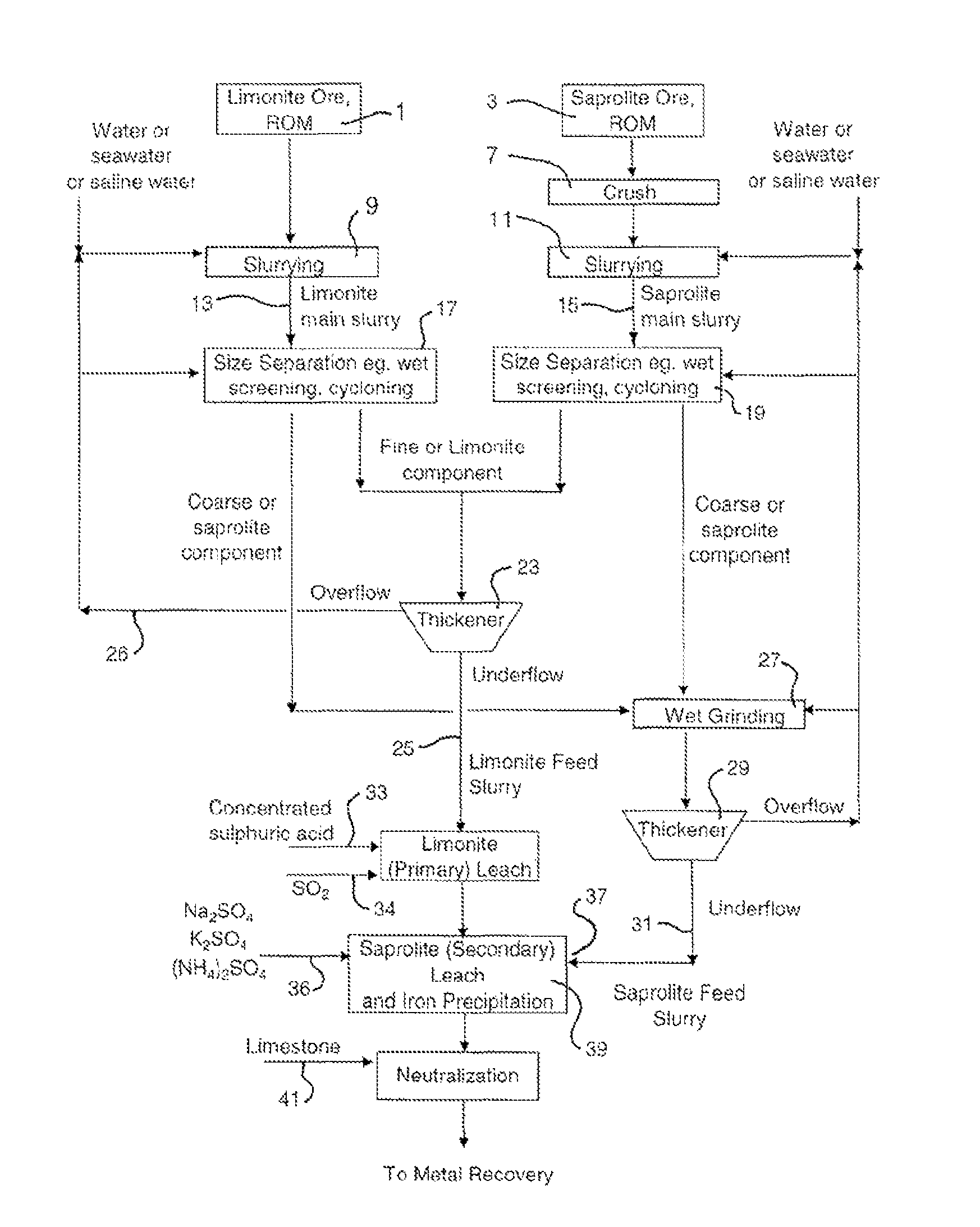Atmospheric acid leach process for laterites
a technology of atmospheric pressure acid and leaching process, which is applied in the direction of solvent extraction, separation process, chemistry apparatus and process, etc., can solve the problem that the nickel in the goethite cannot be sufficiently extracted, and achieve the effect of improving the overall nickel and cobalt recovery
- Summary
- Abstract
- Description
- Claims
- Application Information
AI Technical Summary
Benefits of technology
Problems solved by technology
Method used
Image
Examples
example 1
[0062]A lateritic ore sample was sourced from Indonesia and used in this Example (the “Indonesian” sample). The limonite fraction from this Indonesian sample had an iron content of 49%. Mineralogy characterization indicates that the goethite content in the limonite fraction and the saprolite fraction was 92% and 35% respectively. It was found that the saprolite sample had less leaching reactivity and neutralization capacity than a laterite sample from Gag Island which was used in the Examples of PCT / AUO3 / 00309 (the “Gag Island” sample).
[0063]Atmospheric acid leach amenability tests were performed on the Indonesian sample ores. The results show that nickel recovery from the limonite fraction of the Indonesian sample meets expectation, whereas Ni recovery from saprolite fraction was low. The low reactivity was caused by the Indonesian sample's high goethite content (35%) in the saprolite fraction, which was not reactive during the secondary leach step. Therefore, nickel embedded in go...
example 2
[0069]Ore processing of an Indonesian laterite ore was performed by wet screening to treat the limonite and saprolite fractions, respectively. The screen size was 355 micron. The under screen fractions were combined as limonitic ore feeding for AAL and the over screen fractions were combined as saprolitic ore feeding for AAL. Table 4 illustrates the up-grade results of limonitic and saprolitic ore based on nickel, iron, magnesium and silicon contents at a separation size of 355 micron.
[0070]
TABLE 4Up-graded Limonite and Saprolite Compositions (%)Wet Screen Size: 355 micronFractionSi %Fe %Mg %Ni %IndonesianBulk ore1.348.70.81.65LimoniteOver size0.929.94.20.51Under size1.350.00.31.70IndonesianBulk ore19.211.716.13.12SaproliteOver size20.88.918.14.06Under size15.423.19.92.95
example 3
[0071]Ore processing by size separation was performed on an Indonesian laterite ore to variously treat the saprolite fraction. Tables 5 to 7 illustrate the up-grade results of saprolitic ore obtained, based on nickel, iron, magnesium and silicon contents at separation sizes of 100, 63 and 45 micron, respectively.
[0072]
TABLE 5Up-graded Saprolite Compositions (%)At Separation Size: 100 micronFractionMass %Si %Fe %Mg %Ni %IndonesianBulk ore10019.311.716.03.15SaproliteOver size74.420.97.718.82.79Under size25.614.623.39.24.22
[0073]
TABLE 6Up-graded Saprolite Compositions (%)At Separation Size: 63 micronFractionMass %Si %Fe %Mg %Ni %IndonesianBulk ore10019.311.716.03.15SaproliteOver size76.820.87.918.22.82Under size23.214.324.28.84.28
[0074]
TABLE 7Up-graded Saprolite Compositions (%)At Separation Size: 45 micronFractionMass %Si %Fe %Mg %Ni %IndonesianBulk ore10019.311.716.03.15SaproliteOver size78.320.78.118.12.83Under size21.714.124.78.64.31
PUM
| Property | Measurement | Unit |
|---|---|---|
| particle size | aaaaa | aaaaa |
| temperature | aaaaa | aaaaa |
| temperatures | aaaaa | aaaaa |
Abstract
Description
Claims
Application Information
 Login to View More
Login to View More - R&D
- Intellectual Property
- Life Sciences
- Materials
- Tech Scout
- Unparalleled Data Quality
- Higher Quality Content
- 60% Fewer Hallucinations
Browse by: Latest US Patents, China's latest patents, Technical Efficacy Thesaurus, Application Domain, Technology Topic, Popular Technical Reports.
© 2025 PatSnap. All rights reserved.Legal|Privacy policy|Modern Slavery Act Transparency Statement|Sitemap|About US| Contact US: help@patsnap.com


